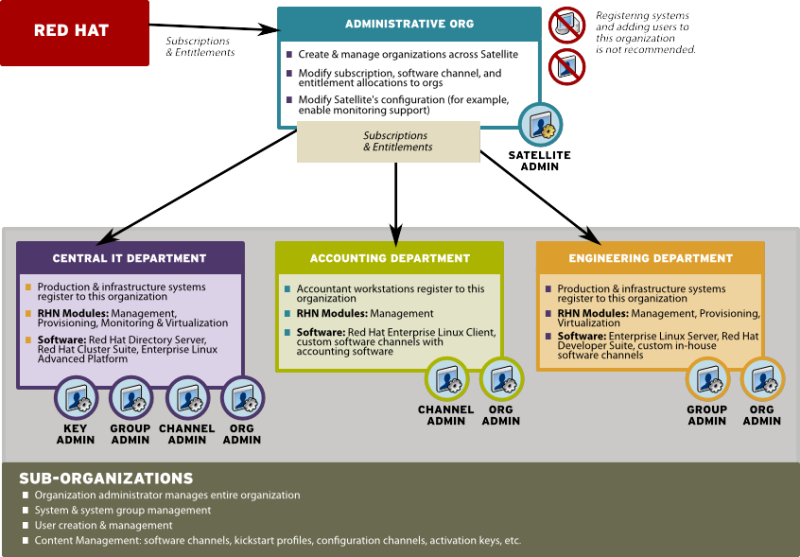Red Hat Training
A Red Hat training course is available for Red Hat Satellite
2.3. Managing Multiple Organizations
Red Hat Satellite supports the creation and management of multiple organizations within one Satellite installation, allowing for the division of systems, content, and subscriptions across different organizations or specific groups. This section guides the user through basic setup tasks and explains the concepts of multiple organization creation and management within Red Hat Satellite.
2.3.1. Modeling your Satellite for Multi-Organization Use
The following examples detail two possible scenarios using the multiple organizations (or multi-organization) feature. It is a good idea to create an additional organization and use it on a trial basis for a limited set of systems/users to fully understand the impact of a multi-organization Satellite on your organization's processes and policies.
2.3.1.1. Centrally-Managed Satellite for A Multi-Department Organization
In this first scenario, the Red Hat Satellite is maintained by a central group within a business or other organization (see Figure 2.1, “Centralized Satellite Management for Multi-Department Organization”). The Satellite administrator of Organization 1 (the administrative organization created during Satellite configuration) treats Organization 1 (the 'Administrative Organization') as a staging area for software and system subscriptions and entitlements.
The Satellite administrator's responsibilities include the configuration of the Satellite (any tasks available under the Admin area of the web interface), the creation and deletion of additional Satellite organizations, and the allocation and removal of software and system subscriptions and entitlements.
Additional organizations in this example are mapped to departments within a company. One way to decide what level to divide the various departments in an organization is to think about the lines along which departments purchase subscriptions and entitlements for use with Red Hat Satellite. To maintain centralized control over organizations in the Satellite, create an Organization Administrator account in each subsequently created organization so that you may access that organization for any reason.

Figure 2.1. Centralized Satellite Management for Multi-Department Organization
2.3.1.2. Decentralized Management of Multiple Third Party Organizations
In this example, the Satellite is maintained by a central group, but each organization is treated separately without relations or ties to the other organizations on the Satellite. Each organization may be a customer of the group that manages the Satellite application itself.
While a Satellite consisting of sub-organizations that are all part of the same company may be an environment more tolerant of sharing systems and content between organizations, in this decentralized example sharing is less tolerable. Administrators can allocate entitlements in specific amounts to each organization. Each organization will have access to all Red Hat content synced to the Satellite if the organization has software channel entitlements for the content.
However, if one organization pushes custom content to their organization, it will not be available to other organizations. You cannot provide custom content that is available to all or select organizations without re-pushing that content into each organization.
In this scenario, Satellite Administrators might want to reserve an account in each organization to have login access. For example, if you are using Satellite to provide managed hosting services to external parties, reserve an account for yourself to access systems in that organization and push content.

Figure 2.2. Decentralized Satellite Management for Multi-Department Organization
2.3.1.3. Recommendations for Multi-Organization Use
Regardless of the specific model you choose in the management of your multi-organization Satellite, these recommendations should be noted.
Administrative organizations (organization #1) should not be used to register systems and create users in any situation, unless you intend to:
- Use the Satellite as a single organization Satellite
- Are in the process of migrating from a single organization Satellite to a multiple organization Satellite
This is due to the following reasons:
- The administrative organization is treated as a special case with respect to entitlements. You can only add or remove entitlements to this organization implicitly by removing them or adding them from the other organizations on the Satellite.
- The administrative organization is a staging area for subscriptions and entitlements. When you associate the Satellite with a new certificate, any new entitlements will be granted to this organization by default. In order to make those new entitlements available to other organizations on the Satellite, you will need to explicitly allocate those entitlements to the other organizations from the administrative organization.
- The Satellite server may only contain as many systems as there are entitlements in the Satellite certificate. Evaluate each organization's entitlement usage on the Satellite and decide how many entitlements are required for each organization to function properly. Each organization administrator should be aware of the entitlement constraint and manage the system profiles as required. Should there be any issues, the Satellite administrator can step in to mediate entitlement concerns.
Note
When logged in under a Satellite administrator, you cannot decrement the allocated entitlements to an organization below the number of entitlements that organization has actively associated with system profiles.

